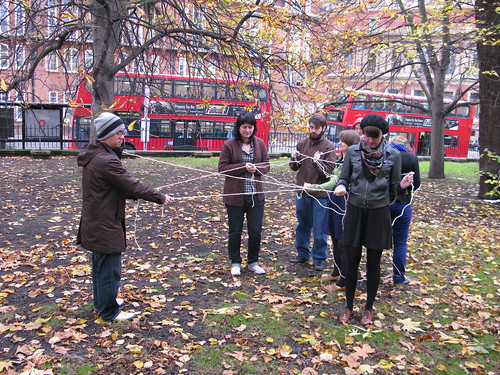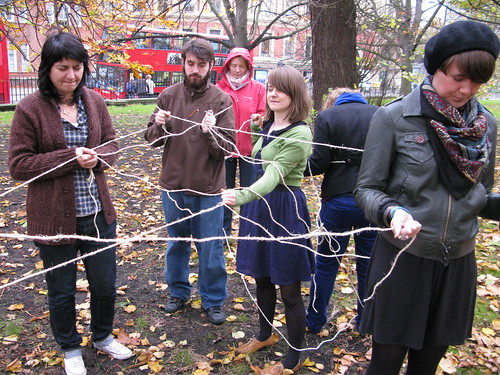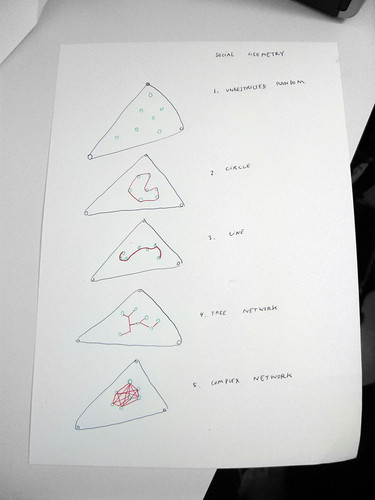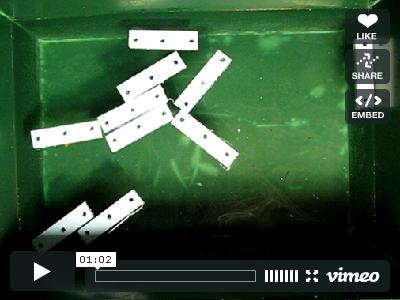I would like to talk about 4 experimental setting in social geometry. Chess. Social geometry. Floating bits. Swarm Operating system.
————————————-
Chess.

In the game of chess there is this incredible tension that is always here. Every piece contains a potential for movement, static objects suggests vectors of movements, radius of action, patterns of movement. It is politics as much as it is cannibalism, or the pretty dance of death.
————————————-
Social Geometry.
I made this experiment, I called “social geometry” :
0. Settings
Make the people stand up, encircle a wide are around them with a rope without touching them. Big enough to move, potentially small enough to make them collide often.
1. Unrestricted random :
Ask them to close their eyes.
Spin on themselves until they’ve lost original orientation and relative positioning of other participants.
Ask them to walk eyes closed in random direction.
Ask to stop, stand still with eyes closed and imagine a mental map of their position in the shape and other participants positions.
Ask to open their eyes, compare their blind mental map and the reality.
2. Circle :
Walk around them with a rope, create a circle the participant hold onto on the outerskirt. Ask people inside the circle to come at the edge.
Ask them to walk eyes closed in random direction. (same)
Ask someone “take the lead”, someone (maybe several people) Simultaneously auto-elect themselves and pull the group in a direction they decided.
Ask to stop, stand still with eyes closed and imagine a mental map of their position in the shape and other participants positions. (same)
Ask to open their eyes, compare their blind mental map and the reality. (same)
3. Line :
Cut the rope, open the circle, it becomes a line.
Then, eyes closed; walk in random position; someone (several people) take the lead; stop; mental map; eyes open; compare mental map and reality.
4. Tree network :
Cut the rope in small pieces, add many small branches, create a simple tree network.
Then, eyes closed; walk in random position; someone (several people) take the lead; stop; mental map; eyes open; compare mental map and reality.
5. Complex network :
Add many many conexions between them, create complex newroks, each participant should have at least 4 threads to hold, leave some conexion loose, some conexion under tension.
Then, eyes closed; walk in random position; someone (several people) take the lead; stop; mental map; eyes open; compare mental map and reality.
Observations, report :
Random may not be the right term because behavioral pattern emerge in each experiments. Or organization quickly emerges.
1. Unrestricted random : participants are new to the experiment, they fear collision and focus on avoiding them. Participants quickly have different attitudes : hands spread ahead as antennas, or just giving up security and walking hands in their pockets.
2. Circle : The shape is shifting position smoothly, when I ask someone to take the lead, the harmony is suddenly broken. Dynamic shape, easy to read and people are moving fast.
3. Line : The line often turns into a “S” and when people are touching, the “S” inverts. The movement is very disorganised unless the one taking the lead is at one extremity. People at the extremity are unlikely to take the lead since they are the less connected.
4. Tree network : Quite stable shape, the overall population remains in the same comfortable area and spread, very little overall movement. Acurate mental map thanks to the tensions in the network. Many people take leadership at the same time and create disorganised movements.
5. Complex network : Interelational links getting tighter, static geometry, very efficient at moving as it is a compact “organism”, when someone takes a clear leadership.
Single individual have a strong movement and involvment signature, but the quality of the connexion make patterns of behavior emerge : the type of connexion creates a dynamic pattern. The duration of each experiment is crucial (here each 4 minutes) and confidence builds up : ultimately the structure becomes more dynamic, moves more quickly, as if moving together in a single direction was a collective target synonim with efficiency.
Within the group, the person who takes the leadership is well negociated : people auto-regulate and people who take leadership are changing at every experiments.
2 individual profile emerge : static spreader | dynamic leader : some people like to spread out in space and relax | some people like to interact with other and create shapes, complex dynamic emerge, one overall shape has active and passive points…
————————————-
Floating bits.
I wanted to know what happen when passive bodies interact ; in opposition to active bodies (humans). Passive bodies interact with “invisible forces”, surface tension, get closer with capillary action, fluid viscosity. Human are so much more complicated than floating bits, yet floating bits and the physics behind it, and the “insible forces” (do you know dark energy?) are so interesting to study and be inspired from. Imagine a chess game the size of the universe… where everything works according to unknown forces, completely different than gravity…
————————————-
Swarm Operating system.
There are attractors – actors (yellow moving dots) want to get close to / there are repellant – actor want to get away from / you can adjust the level of “collaboration” or proximity between actors, basically the density of a group.
The idea is to create politics assisted by computer, an object oriented politic (concept of “dingpolitiks” Bruno Latour, “Making Things Public“, MIT press 2005).
With Hiromi Ozaki on http://hi-ve.net we tried to re-create a little bit of the complexity of human behaviour and optimize it on real scientifical datas, with highly customizable individual variables. Actors automatically create “groups of interest” and keep on interacting within those in dynamic movement patterns.
————————————-
With dance, how can we take such thinking further?
You must be logged in to post a comment.





This post is not unrelated to the orgy post just before.
Swarms may be “mobile orgies”, a rush fleet for a vibrant life.
[…] Original post http://www.iwishicoulddescribeittoyoubetter.net/overseas/?p=508 […]
there is an artists i went to school of the art institute of chicago with in late 80’s early 90’s (sorry i don’t have Her name or website with me) She knits red hats and connects them with red ribbons to each head of a person . they then interact with each other by walking around ,crossing streets ect. She even does complicated “marching band” type of formations in wich everyhead is connected by these ribbons as they move in patterns changing formations.
She also knits red mittens and sweaters and does simular experiments. Her artwork seems related to what you are talking about here. She lives in St Louis Ms USA now i think
[…] appeared as a form of aesthetic constitution—meaning the sensory constitution—of the community: the community as a way of occupying time and space, as a set of living gestures and attitudes that stands before any kind of political form and […]
resell proxy
I found a great…
cheap private proxies
I found a great…